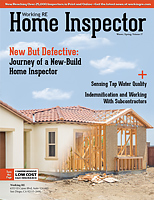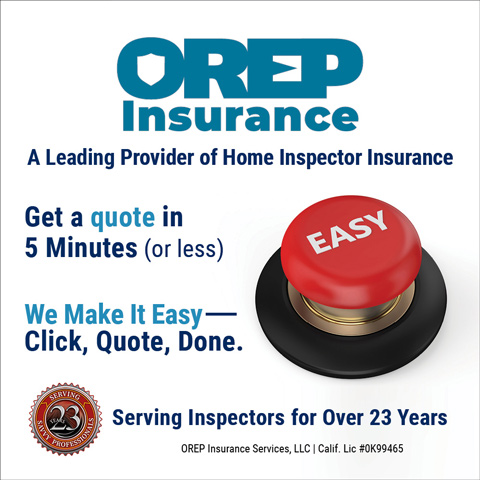 | > E&O/GL Insurance for Home Inspectors Competitive Rates, Broad Coverage, Free Risk Management, online inspection support for tough questions, discounts on education and more… Professional Coverage, Competitive Pricing Shop OREP today! |
Indemnification and Working With Subcontractors
by Isaac Peck, Senior Broker at OREP.org
Home inspectors are no strangers to hiring other professionals, including other home inspectors, so they can meet their clients’ needs or be a one-stop-shop in their market. While subcontracting is a smart and potentially rewarding practice, it’s important to understand and manage the risks involved with subcontracting, and in particular, how to protect yourself from the liability incurred by the subcontractor. Indemnification is a common and effective way to manage those risks.
A home inspector might hire another home inspector as an independent contractor to handle overflow work. Or they might hire various professionals to conduct the specialized parts of the inspection: an environmental professional to conduct mold testing, a plumber to conduct sewer scoping, or a pest control professional to conduct a pest inspection. Such efforts allow the inspector to capture additional revenue while providing a convenient and comprehensive set of services to their clients. In some markets, offering additional services like this is a competitive advantage, or even necessary to compete with other inspectors.
For those home inspectors who do work with subcontractors, there are two very important things the inspector needs to do with each professional: First, get a copy of each subcontractor’s liability insurance. Second, have a signed, written agreement with the subcontractor that includes an indemnification clause where the subcontractor agrees to indemnify the home inspector.
While some home inspectors do take the step of verifying current liability insurance, very few go the extra mile and get that signed agreement with their subcontractors—and even fewer include an indemnification clause in that agreement. Let’s talk about what indemnification means, and why it’s helpful in risk management.
What is Indemnification?
Let’s start with what it means to “indemnify” someone. The Merriam-Webster Dictionary defines “indemnify” as:
- To secure against hurt, loss, or damage;
- To make compensation for incurred hurt, loss, or damage.
In other words, an indemnification clause ensures that the subcontractor is agreeing to defend the home inspector against legal claims and make them “whole” (compensate them for losses) in the event the home inspector is sued or held liable for mistakes that the subcontractor makes.
Indemnification clauses are common amongst construction trades, real estate professionals, wedding services, financial services, and other client-based professions. For example, if you are a general contractor hired by a wealthy patron to build a house, you’ll likely hire a framing company to frame the house, an electrical company to wire it, and so on. In each case, the best risk management practice is to have these subcontractors sign indemnification clauses where they agree to take responsibility for any property damage, mistakes, or errors that they make. After all, even though you are the general contractor, if your subcontractors make mistakes, you want them to take responsibility and pay for it. You don’t want to be left holding the bag.
It’s just good risk management—and OREP provides its members with an attorney-prepared Subcontractor Agreement they can use with their subcontractors—free of charge.
A Practical Example: Home Inspection
Here’s a story straight from the trenches about why using an indemnification clause is a good risk management practice for any home inspector that is hiring a subcontractor.
OREP serves roughly 2,000 home inspectors with liability insurance and recently had the privilege of defending a home inspector on a claim in the Midwest. This home inspector was offering clients pest inspection services alongside his regular home inspections. The inspector would charge $80 for the pest inspection and then hire a pest professional to do the inspection for $50, pocketing a cool $30 on every transaction. Sounds like good business, right?
In this case, the OREP home inspector told us that the pest professional was his “buddy” and that he had seen a copy of the guy’s liability insurance, but didn’t have a copy on file. Additionally, there was no written agreement between himself and his subcontractor “buddy.”
The inspector and subcontractor kept their working relationship going for a couple of years when some new homeowners who had hired the inspector moved into their house and did a “gut-to-the-studs” remodel, pulling out all the drywall with plans to completely update the home.
Guess what they discovered? Termite damage. Lots of it. It had been concealed by the drywall and was not visible to the home inspector or to the pest inspector.
Here’s the thing. This is exactly the type of claim that would traditionally be made directly to a pest professional. But in this case, because the home inspector is the one who was hired and paid to perform the pest inspection, the home inspector is the one with the liability.
But what about the “buddy?” He’s the one who actually did the inspection for termites. Do you think that he, his company, or his insurance carrier would voluntarily step up and take responsibility for this claim? The answer is no. The pest professional and his insurance carrier are breathing a sigh of relief that they were not named in the lawsuit and that they are, so far, completely unencumbered by the entire ordeal.
And so the home inspector was left to defend this claim all by himself. The only recourse a company has against a subcontractor like this would be to file a claim against the subcontractor and potentially sue them. In other words, the home inspector would need to sue the pest professional himself, while defending a lawsuit from the homeowner. Many insurance companies and professionals are very uncomfortable with this approach (unless the dollar amounts are very high), and in many cases, the subcontractor will get off scot-free if there is no written agreement between the two parties outlining responsibilities and liabilities.
Two things would have prevented the home inspector from getting stuck with all the liability: a copy of the pest professional’s insurance policy, and a written agreement with an indemnification clause. Those tools would have allowed the home inspector to tender the claim directly to the pest professional’s insurance carrier and seek compensation and defense in the lawsuit.
(story continues below)
(story continues)
Another Practical Example: Mortgage Field Pros
Here’s another example. OREP also serves mortgage field professionals with insurance and risk management. These professionals help banks and other large property managers manage their inventory of bank-owned properties (REOs). Their services include boarding up windows, mowing lawns, property maintenance and even property clean-outs—where a firm will go into a home and empty it of all furniture, belongings, and trash.
The relationship between these professionals is structured like this: typically, there are larger vendors that service big contracts with a lender. They then subcontract out the jobs to smaller firms across the U.S. Just like with appraisals, lenders try to avoid administering their own panel of thousands of vendors across the country.
In one claim OREP has seen, a local mortgage field firm was hired by a larger vendor to perform a “clean out” on a particular property that had been foreclosed on. But the smaller firm made a serious error: they didn’t verify the address and ended up getting it wrong. So they drove up to the wrong house, kicked in the front door, and cleaned it all out, putting all of the legitimate homeowner’s current belongings out on the front lawn.
As you can imagine, this resulted in a very big claim. But because the larger vendor didn’t have an indemnification clause in their service agreement, they couldn’t transfer the liability onto the smaller firm that had made the mistake! As a result, the larger vendor ended up defending, and finally settling, a serious claim.
You’d hope they could recover from that one disaster, but it’s more complicated than that. This big vendor was doing big business, and their faulty contracts created more problems for them, and eventually the company faced six-figure insurance premiums, with few carriers willing to even quote their business. In fact, the only insurance carrier that was willing to quote their business demanded that they start including—you guessed it—indemnification clauses in all their service agreements as a condition of coverage.
Be Smart When Hiring Subcontractors
I tell these stories to home inspectors when they ask me about indemnification clauses. Common law indemnification theory dictates that the party responsible for the mistake should pay for it. From a practical standpoint (especially when it comes to insurance), indemnification clauses make all the difference. In other words, from a risk management perspective, any business that is working with subcontractors, or even businesses that allow subcontractors on their properties (like builders or wedding venues, for example), should be asking those subcontractors to sign an agreement with an indemnification clause. This is true for home inspectors as well.
Be Smart When You Are the Subcontractor
If you’re the one working for a large vendor, another home inspector, or any business subcontracting out to you, you should not be surprised to see indemnification provisions in your agreement. But there’s an important difference you should keep an eye out for.
Specifically, you never want to sign any agreement where you agree to indemnify any third-party for their mistakes or errors. You should only indemnify a third-party for your own errors or omissions. From an insurance standpoint, if you agree to indemnify a third-party for their own mistakes and errors, that is not something your insurance will cover. So watch out for that.
How Can I Help?
If you ever have any questions about liability or risk management in your home inspection business, please reach out to me directly at isaac@orep.org or give OREP’s office a call: (888) 347-5273. We are now open 12 hours a day to better serve home inspectors across the country! (8 a.m. – 8 p.m. ET) Stay safe out there!
About the Author
Isaac Peck is the Publisher of Working RE magazine and the Senior Broker and President of OREP.org, a leading provider of E&O insurance for savvy professionals in 49 states and DC. Over 14,000 professionals trust OREP for their E&O. Isaac received his master’s degree in accounting at San Diego State University. Reach Isaac at isaac@orep.org or (888) 347-5273. CA License #4116465.
OREP Insurance Services, LLC. Calif. License #0K99465


